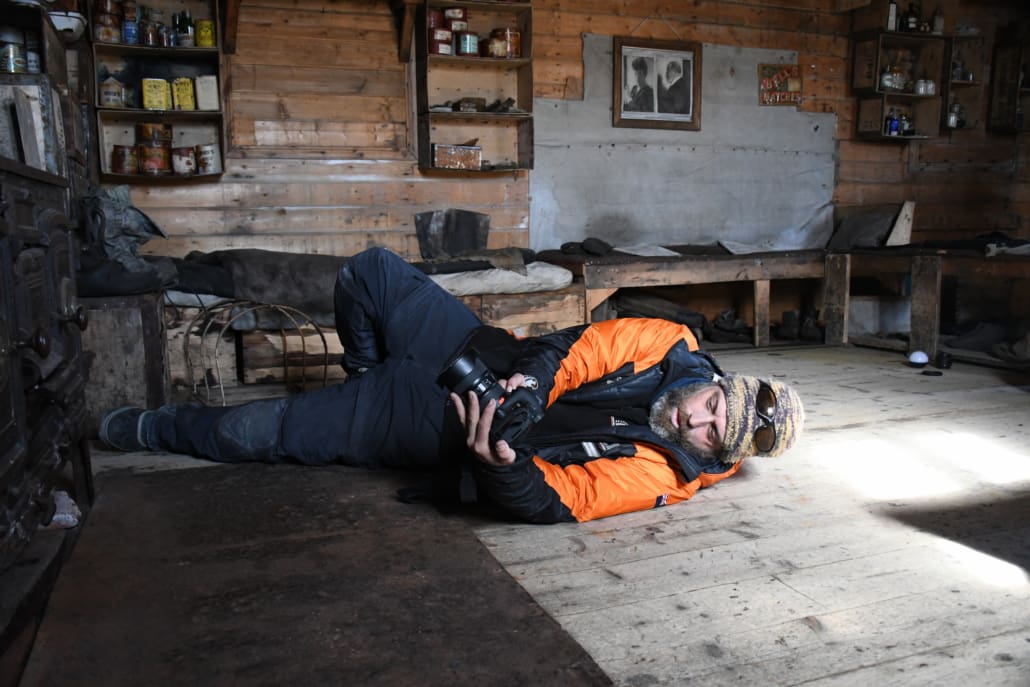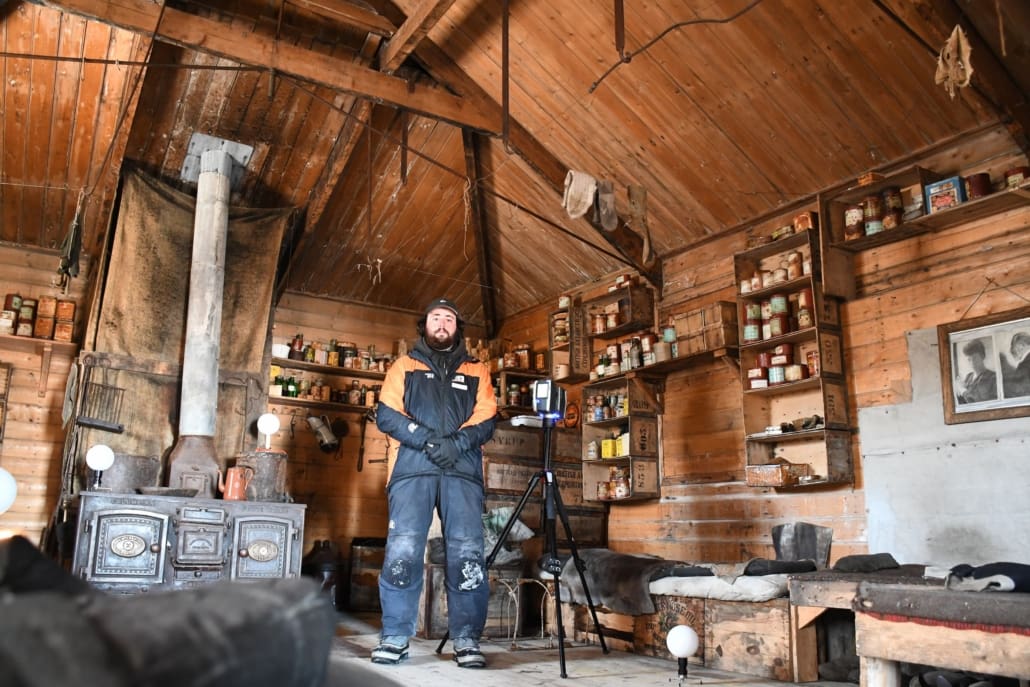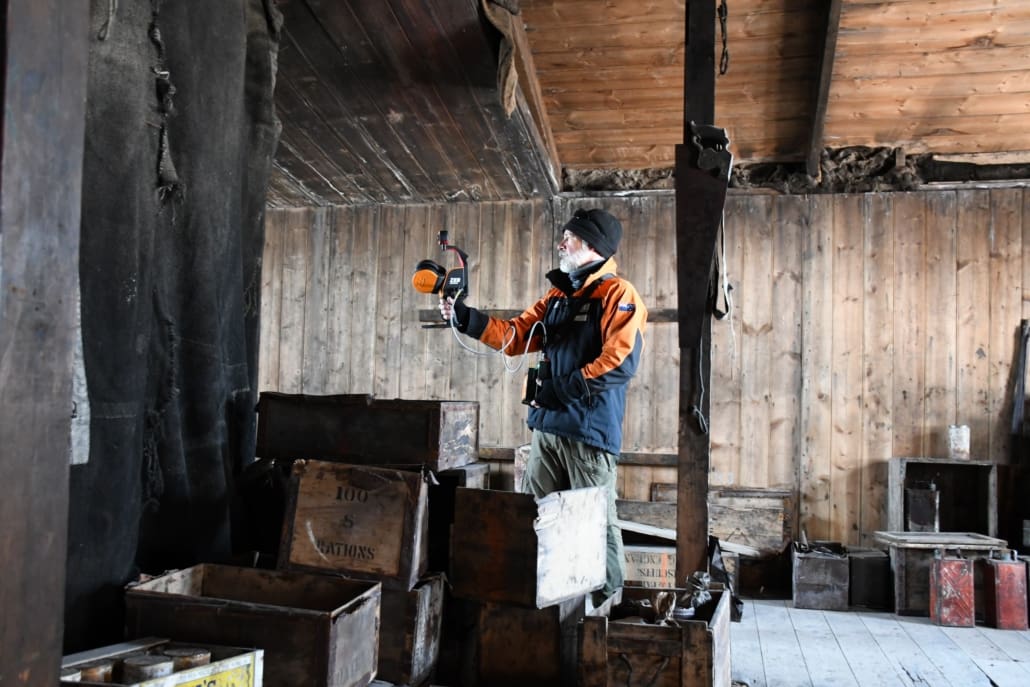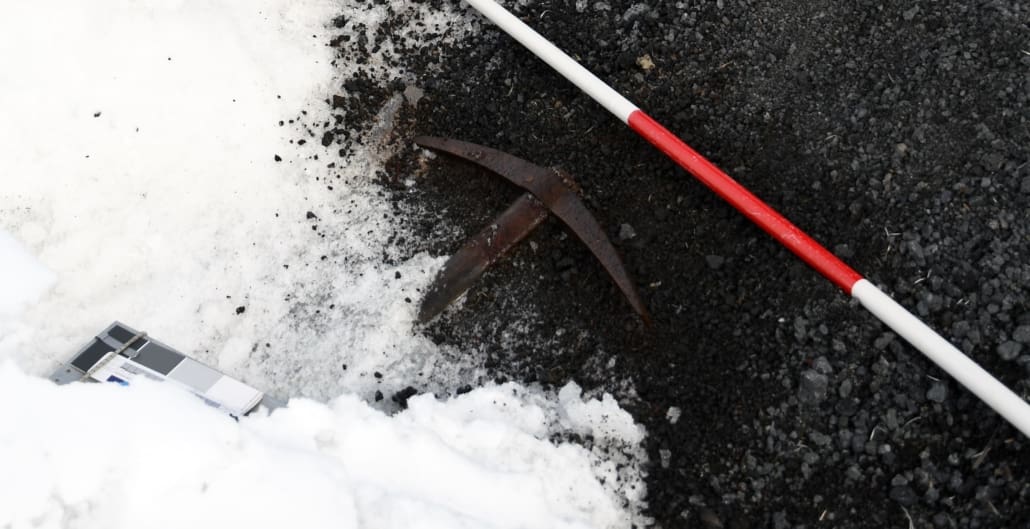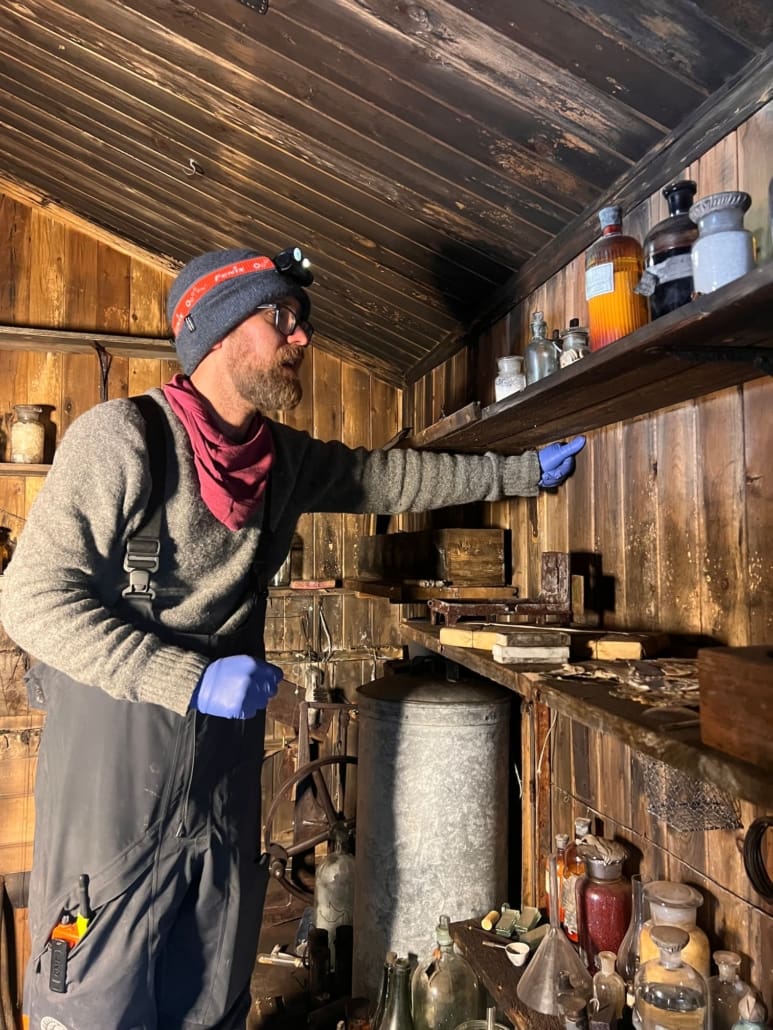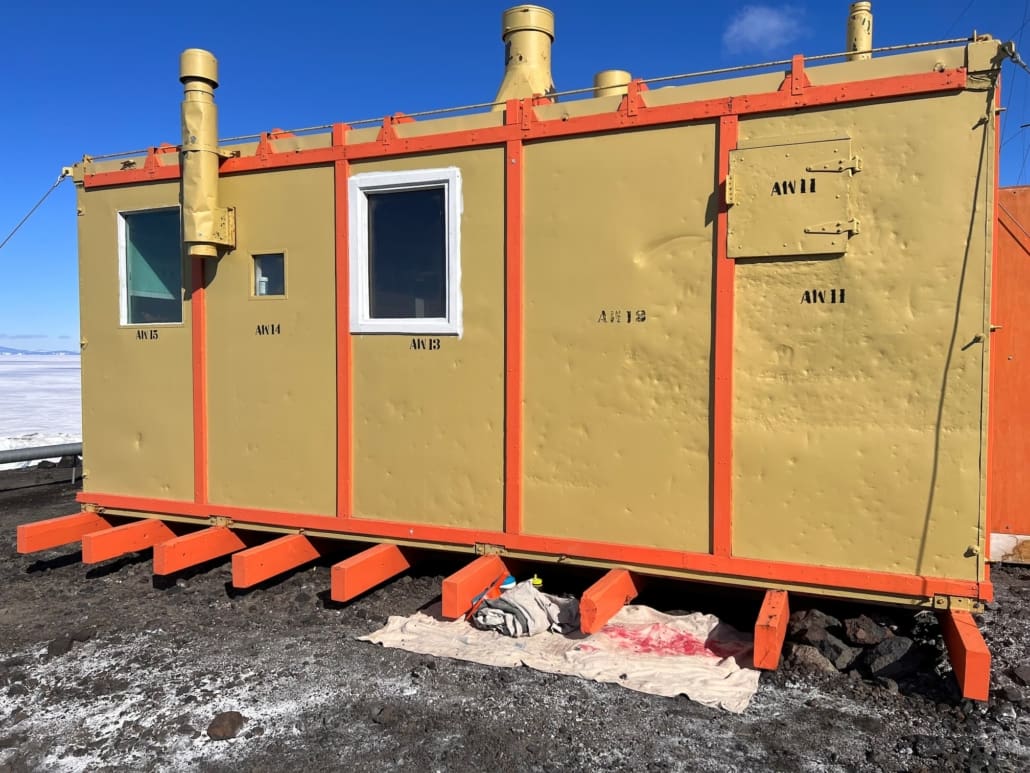2023/24 Summer Conservation Season – Ross Island
The Trust’s On-Ice Conservation team outside Shackelton’s ‘Nimrod’ hut at Cape Royds (from left) Trust Building Conservation Manager Zack Bennett, Heritage Consultant Gord Macdonald, Conservator Conor Tulloch, Lead Conservator Nicola Stewart and Conservator Gretel Evans. ©AHT/Zack Bennett
The Trust’s On-Ice Conservation team spent thirteen weeks in Antarctica this season, from early November until late January, undertaking an intensive digital data capture project, followed by the annual conservation programme at the historic Ross Island explorer bases of Captain Robert Falcon Scott, Sir Ernest Shackleton, and Sir Edmund Hillary.
Digital Data Capture at Historic Huts
The first of two Antarctic field deployments for Trust staff for the 2023/24 season saw a team of four spend three weeks at Cape Evans and Cape Royds, successfully completing LiDAR and photogrammetry work at Scott’s Terra Nova hut and Shackleton’s Nimrod hut. This was supported by Antarctica New Zealand’s Community Engagement Programme, and the Trust extends its thanks for making this event possible.
With field leadership from Trust Building Conservation Programme Manager Zack Bennett, conservation support from Conservator Conor Tulloch, and data capture by StaplesVR videographer Charles Hill and contractor Brendan Wade, the team were able to digitally capture, in intricate detail, every aspect and angle of both huts. Utilising state-of-the-art technical equipment generously supplied by StaplesVR, the team’s efforts were monumental, capturing an impressive 33,000 photos at Cape Evans and 17,000 at Cape Royds.
For first time Antarctican Brendan Wade, the experience of working in the huts was deeply profound. Brendan reflected, “Being a seafarer, these places hold special significance to me — particularly with the hardships these parties endured and the isolation they were subject to. To be given the opportunity to acquaint myself so intimately with the huts is a privilege beyond comparison.”
Brendan and Charles appreciated working alongside Trust staff Zack and Conor, who were able to share insights into the huts and why documenting them in great detail is such important work. “Having Zack and Conor from the Trust supporting us and giving us our daily dose of history, answering questions, and explaining some of the story of the huts and artefacts has brought me an unexpected closeness to this place. It looks and feels like a museum exhibit, but it is so much more. It was a home, a refuge, and a shelter,” said Brendan.
The Trust is working with experts to interpret and process this data, which will support conservation change management at the historic sites. Executive Director Francesca Eathorne says, “The data will also help the Trust to continue creating immersive digital experiences, which will enable people around the world the opportunity to virtually visit these historic huts and gain a deeper understanding of their significance in shaping the course of Antarctic history.”
Brendan Wade undertaking photogrammetry inside Shackelton’s ‘Nimrod’ hut. ©AHT/Zack Bennett
Charles Hill during LiDar scanning of Shackelton’s ‘Nimrod’ hut interior. ©AHT/Zack Bennett
Monitoring Programmes and Archaeology
After completing the data capture, the two technicians returned to New Zealand, while Zack and Conor spent the next few weeks working at Scott Base and nearby sites. Conor carried out artefact treatments in the conservation laboratory, in preparation for returning objects back to the huts when the remaining team members arrived. In late December, Zack and Conor were joined by Lead Conservator Nicola Stewart, Conservator Gretel Evans, and Heritage Consultant Gord Macdonald, for the remainder of the summer conservation season which included a series of environmental, building and object monitoring programmes; mould investigation and mitigation; abrasive dust removal; emergency conservation treatments, collection audits and snow and ice mitigation.
“With a long season and at times challenging weather conditions to work in, having experienced and resilient team members like Conor, Nicola, Gretel and Gord was vital to the success of our planned work programme. It was a privilege to celebrate Christmas Day at Cape Royds with such a wonderful team,” said Zack.
Taking advantage of a logistics plan change, Gord Macdonald was able to carry out LiDar scanning and photogrammetry at various Ross Island locations, including the expedition bases at Cape Evans, Cape Royds, and Hut point, as well as the monuments of Vince’s Cross, Our Lady of the Snows Shrine, and Observation Hill Cross.
“LiDar, or light detection and ranging, uses an instrument that emits lasers towards objects in the landscape, and measures how long it takes for the reflected light to bounce back to the instrument. Millions of points are recorded this way, enabling us to create a very precise map of the land’s surface and any objects within it. Recent advances in 3D laser scanning have made this process highly portable, allowing us to map large areas of the historic sites very quickly. Photogrammetry involves taking a high number of digital images from different angles and using specialised software to stitch them together to create a 3D model. We use these techniques to accurately record site conditions so that we can monitor them over time. The data is also used to create accurate drawings and topographical maps,” Gord explains.
Gord Macdonald using a portable laser scanner to scan the interior of Scott’s ‘Discovery’ hut at Hut Point. ©AHT/Zack Bennett
While at Scott’s Terra Nova hut, a thorough survey of site archaeology was completed, including archaeological deposits such as the dog hospital, mutton stacks, and the magnetic instrument stand that was initially buried 25 feet inside an ice cave, but is now visible due to retreating ice.
“The stand was originally housed in an ice cave because a humidity-stable environment was necessary for greater accuracy in measuring magnetic deviation during the ‘Terra Nova’ expedition. The cave was lined with a timber support construction and Gibson quilting, featuring lighting and numerous instrument stands. Over time, this structure has collapsed as ice and snow has retreated. Photogrammetry and a thorough archaeological assessment were carried out in the area to gather sufficient data for analysing how the instrument room was constructed and what it would have looked like,” said Zack.
Historic pickaxe at Cape Evans, between a ranging pole and photographic chart, during archaeological documentation. ©AHT/Zack Bennett
At Shackleton’s Nimrod hut at Cape Royds, the team returned conserved artefacts, re-located some which require further intervention and assessed historic chemicals. At the same time, they took the opportunity to update the artefact records database, undertaking condition checks and audits to improve the accuracy of the records. This is on-going, critical work, ensuring our conservators have a consistent and unbroken collection of data to work from. “Regular audits, updates and spot checks of our records database is important to the Trust’s conservation work as their accuracy sets us up for successful future seasons,” says Zack.
Additional work at Cape Royds included repairs to the rigging straps and tightening the hemp rigging lines that were replaced on the chimney last season. Hemp rigging lines need to be tightened over time due to a natural process called “creep”. Creep is the slow stretching of hemp fibres under continuous tension, exacerbated by exposure to environmental factors like wind and moisture. Periodic tightening is important to uphold tautness and ensure the safety and functionality of the rigging system, and stability of the historic chimney.
At Scott Base, significant repairs were undertaken on the door in the main room of Hillary’s TAE/IGY hut. Issues with the worn soft door closer and door hinges were addressed, collaborating with the Scott Base engineers to fabricate a number of new components that had become irreparably worn in the original unit. Additionally, all exterior windows and hatches, and one West exterior wall, were repaired and repainted, with paint generously supplied by Dulux New Zealand.
In the final days of the season, Zack undertook photogrammetry work at Scott’s Discovery hut at Hut Point to support the development of a virtual reality experience of the hut. The Trust extends gratitude to the United States Antarctic Program for supporting Zack in completing this important work.
The Trust also extends its thanks to Antarctica New Zealand for their logistical support throughout the season.
Conor Tulloch working inside Scott’s ‘Terra Nova’ hut. ©AHT/Zack Bennett
Painting underway on Hillary’s TAE/IGY hut. © AHT/Zack Bennett
Cape Adare Conservation Update
The Trust has been planning substantial conservation work on the historic huts at Cape Adare, the site of Borchgrevink’s British Antarctic Southern Cross Expedition (1898-1900). During the planning phase, the Trust identified a possible safety risk around excavation from the suspected remnants of historic ammunition, explosives, and flares that are potentially buried in the environs.
To address this issue, the Trust is working with Antarctica New Zealand who have engaged experts from the New Zealand Defence Force (NZDF) to conduct a site visit to locate and confirm any such materials in the area, and if necessary, plan for their disposal. This work was scheduled to take place during the 2023/24 season; however, Antarctica New Zealand was unable to provide logistics support for the event. The Trust is working with Antarctica New Zealand and NZDF to plan for the completion of this task.
Trust Executive Director Francesca Eathorne says, “We are pleased to continue working with NZDF and Antarctica New Zealand to progress this important work, ensuring we can then safely carry out the conservation of this significant cultural heritage site – the first expedition base built in Antarctica and the only example left of humanity’s first dwelling on any continent.”
Borchgrevink’s huts at Cape Adare, 2015. ©AHT/Lizzie Meek
Trust Heritage Consultant Gord Macdonald was to join the Cape Adare event this season, to provide conservation expertise while the team was at site. As he was already in Antarctica when the event was cancelled, Gord was redeployed to join the Trust’s Ross Island conservation team, where his experience and knowledge were welcomed.


